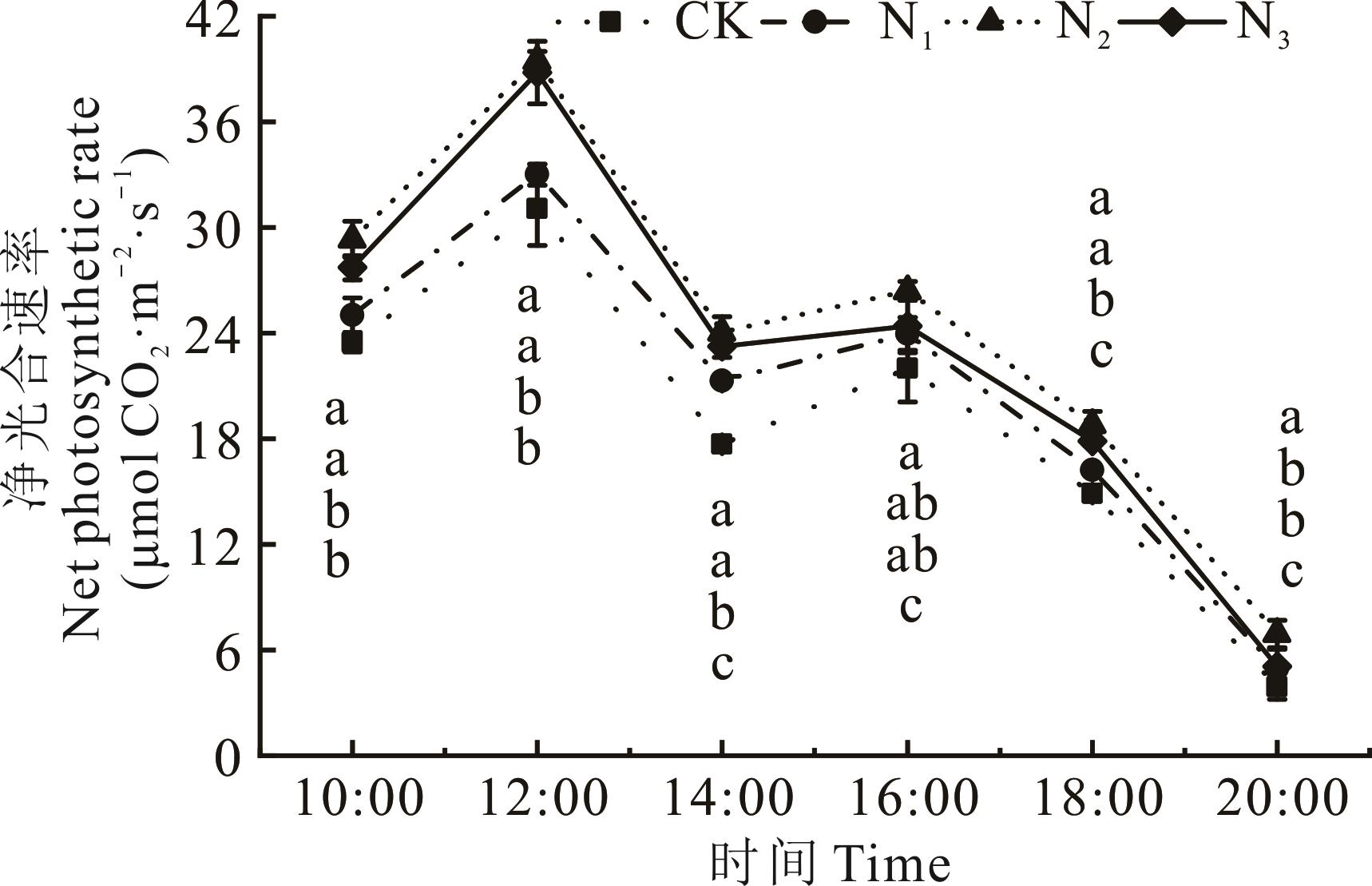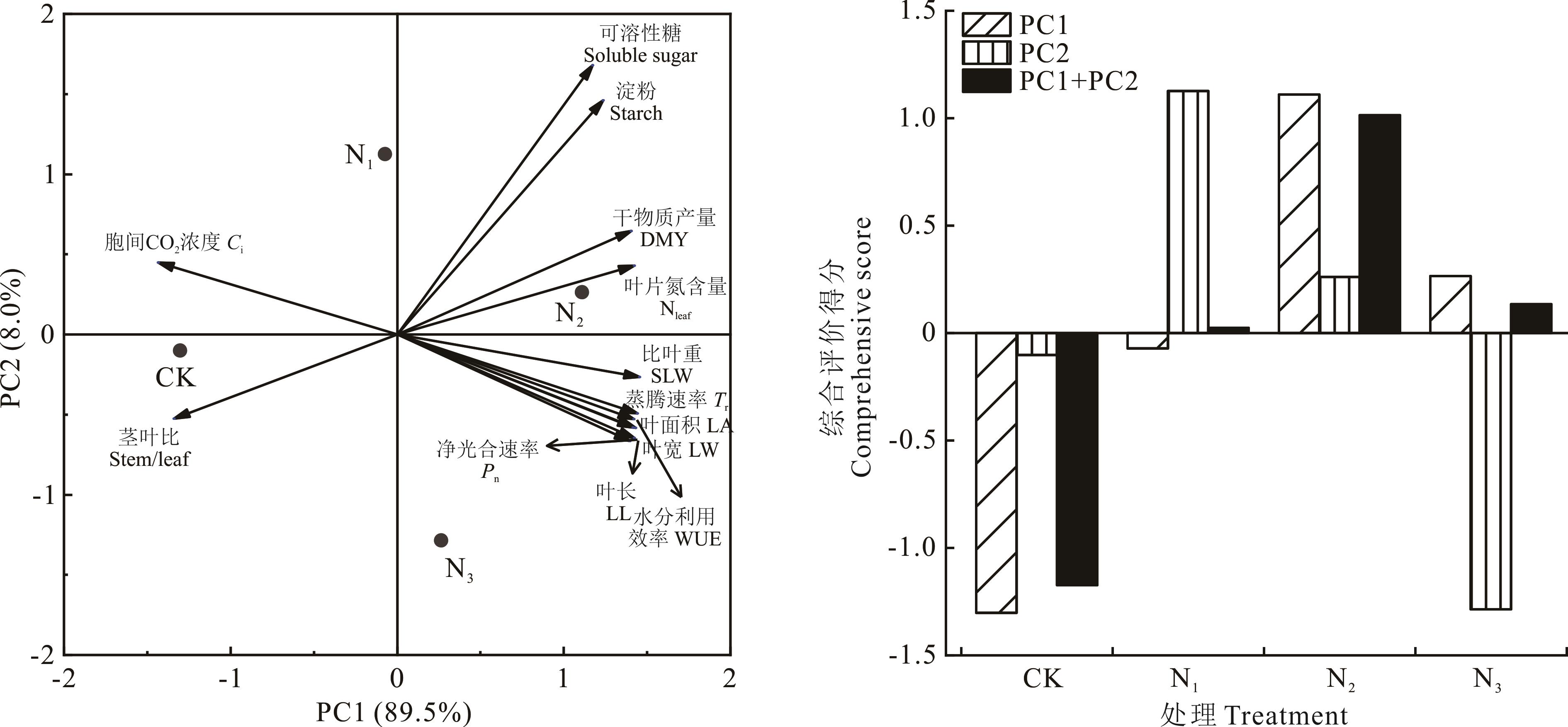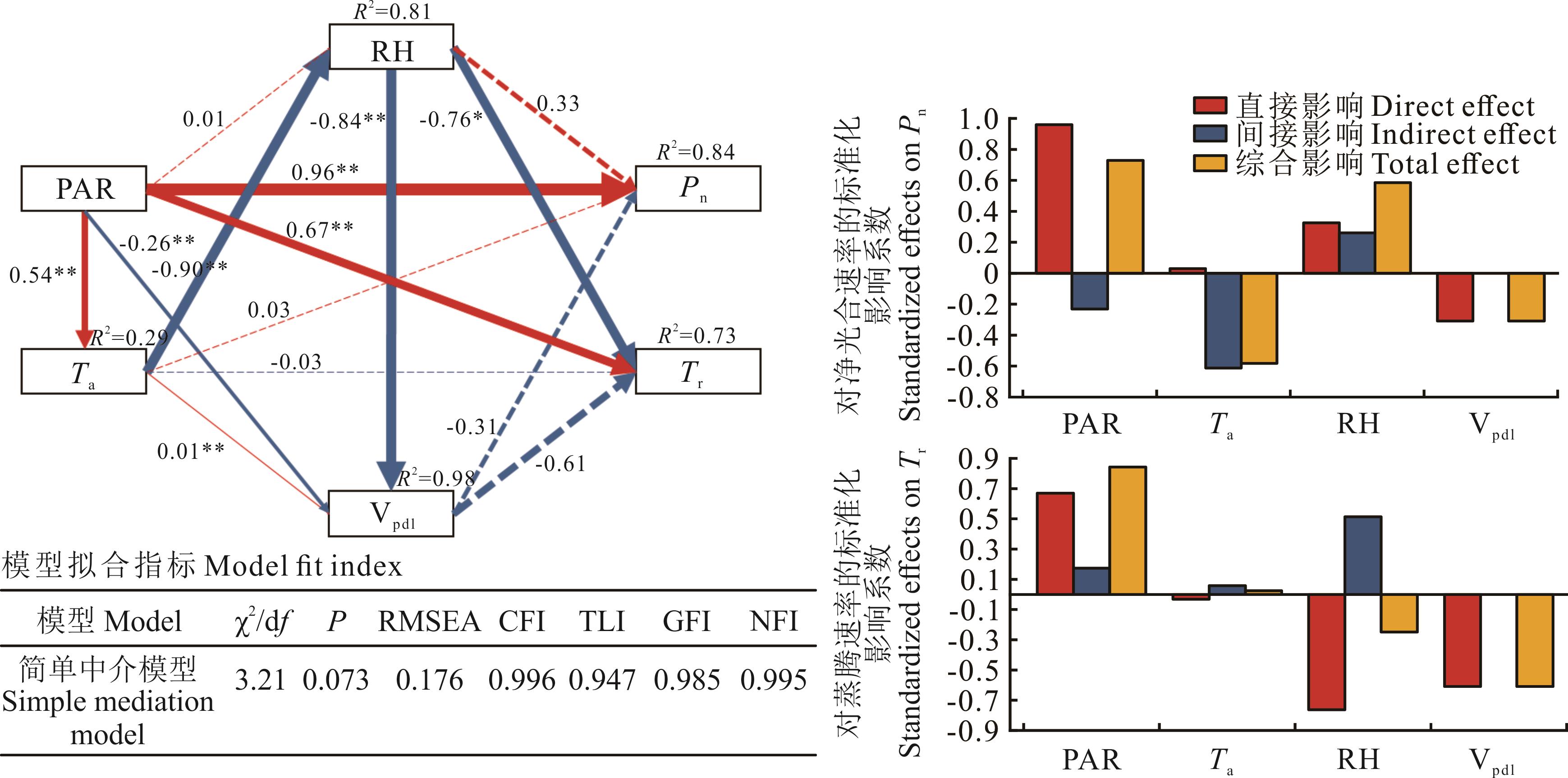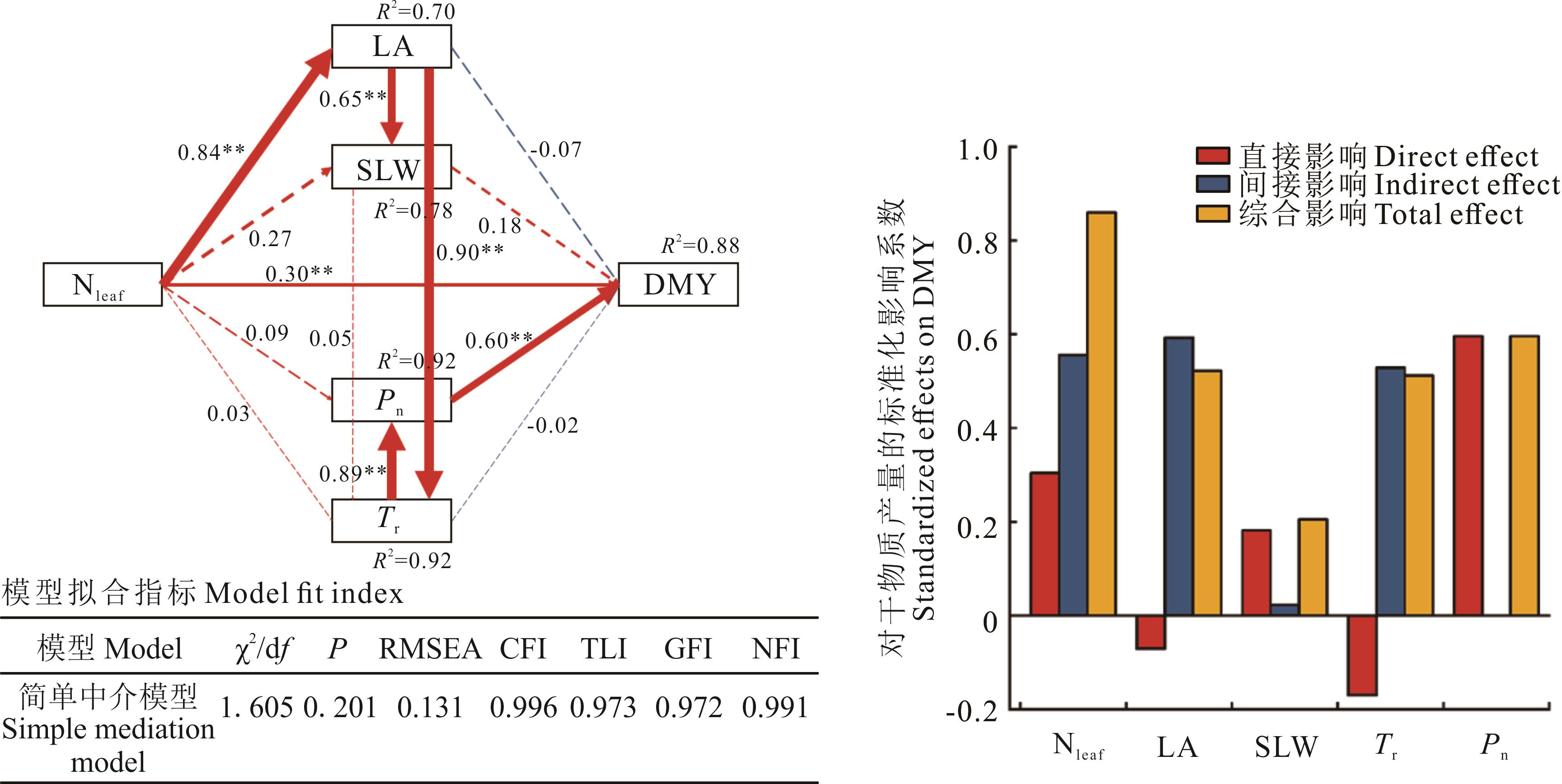

ISSN 1004-5759 CN 62-1105/S


草业学报 ›› 2022, Vol. 31 ›› Issue (9): 63-75.DOI: 10.11686/cyxb2021343
孙延亮( ), 赵俊威, 刘选帅, 李生仪, 马春晖, 王旭哲(
), 赵俊威, 刘选帅, 李生仪, 马春晖, 王旭哲( ), 张前兵(
), 张前兵( )
)
收稿日期:2021-09-13
修回日期:2022-01-25
出版日期:2022-09-20
发布日期:2022-08-12
通讯作者:
王旭哲,张前兵
作者简介:Corresponding author. E-mail: 690953197@qq.com, qbz102@163.com基金资助:
Yan-liang SUN( ), Jun-wei ZHAO, Xuan-shuai LIU, Sheng-yi LI, Chun-hui MA, Xu-zhe WANG(
), Jun-wei ZHAO, Xuan-shuai LIU, Sheng-yi LI, Chun-hui MA, Xu-zhe WANG( ), Qian-bing ZHANG(
), Qian-bing ZHANG( )
)
Received:2021-09-13
Revised:2022-01-25
Online:2022-09-20
Published:2022-08-12
Contact:
Xu-zhe WANG,Qian-bing ZHANG
摘要:
通过研究不同氮素水平下滴灌苜蓿叶片形态特征、光合日变化规律,分析不同施氮水平下滴灌苜蓿光合日变化、叶片形态与干物质产量的关系,以期进一步揭示施氮对紫花苜蓿干物质及产量形成的影响机制,进而为优化实际生产中紫花苜蓿的氮管理策略提供理论依据。采用单因素随机区组设计,设置0(CK)、60(N1)、120(N2)和180 kg·hm-2(N3)共4个施氮水平,在紫花苜蓿初花期对光合日变化、叶片形态、叶片氮含量和苜蓿产量构成进行测定。结果表明,施氮处理下苜蓿的叶片净光合速率、蒸腾速率和水分利用效率均高于不施氮处理,施氮处理的苜蓿叶片胞间CO2浓度低于不施氮处理。对净光合速率和蒸腾速率综合影响最大的环境因子是光合有效辐射。随着施氮量的增加,紫花苜蓿的叶长、叶宽、叶面积、比叶重,以及叶片干重、茎秆干重、干物质产量、叶片氮含量、淀粉和可溶性糖含量均呈先增加后降低的趋势。不同施氮水平下,对叶片形态结构影响最大的为叶面积,其次分别为比叶重、叶长和叶宽,对苜蓿干物质产量影响从大到小依次为叶片氮含量>净光合速率>叶面积>蒸腾速率>比叶重。不施氮和高氮处理下光合速率下降主要是因为光合活性受到抑制,属于非气孔因素。基于主成分分析,干物质产量、叶片形态以及光合作用综合得分最高的为N2处理,其次分别为N3、N1和CK处理。因此,施氮肥有助于紫花苜蓿光合面积和光合速率的协同改进,有利于光合产物的生成,从而促进苜蓿干物质产量的增加,在施氮量为120 kg·hm-2时提升效果最为明显。
孙延亮, 赵俊威, 刘选帅, 李生仪, 马春晖, 王旭哲, 张前兵. 施氮对苜蓿初花期光合日变化、叶片形态及干物质产量的影响[J]. 草业学报, 2022, 31(9): 63-75.
Yan-liang SUN, Jun-wei ZHAO, Xuan-shuai LIU, Sheng-yi LI, Chun-hui MA, Xu-zhe WANG, Qian-bing ZHANG. Effect of nitrogen application on photosynthetic daily variation, leaf morphology and dry matter yield of alfalfa at the early flowering growth stage[J]. Acta Prataculturae Sinica, 2022, 31(9): 63-75.

图2 不同施氮水平下苜蓿叶片净光合速率日变化不同小写字母表示同一时间不同处理间差异显著(P<0.05),显著性标注按照各处理平均值从高到低的顺序进行标注。下同。Different lowercase letters indicate significant differences among treatments at the same time (P<0.05), significance labeling was done in the order of the mean of each treatment from high to low. The same below.
Fig.2 Daily variation of net photosynthetic rate of alfalfa leaves under different levels of nitrogen application

图3 不同施氮水平下苜蓿叶片光合参数日均值不同小写字母表示不同施氮水平下差异显著(P<0.05),F值后**表示处理间差异极显著(P<0.01)。Different lowercase letters indicate significant differences under different nitrogen application levels (P<0.05), and ** after F value indicates extremely significant differences among treatments (P<0.01).
Fig.3 Daily average values of photosynthetic parameters of alfalfa leaves under different levels of nitrogen application
| 处理Treatment | 叶面积Leaf area (cm2) | 叶长Leaf length (mm) | 叶宽Leaf width (mm) | 比叶重SLW (g·m-2) |
|---|---|---|---|---|
| CK | 1.80±0.01d | 25.12±0.18c | 10.62±0.40c | 52.40±0.30c |
| N1 | 1.85±0.01c | 25.80±0.18b | 11.42±0.28b | 53.11±0.13b |
| N2 | 1.95±0.01a | 26.33±0.46a | 12.10±0.25a | 54.15±0.09a |
| N3 | 1.90±0.02b | 26.27±0.32a | 11.94±0.45a | 53.54±0.27b |
| F值F-value | 36.855** | 19.725** | 18.934** | 32.175** |
表1 不同施氮水平下苜蓿叶片形态结构变化
Table 1 Changes in morphological structure of alfalfa leaves under different levels of nitrogen application
| 处理Treatment | 叶面积Leaf area (cm2) | 叶长Leaf length (mm) | 叶宽Leaf width (mm) | 比叶重SLW (g·m-2) |
|---|---|---|---|---|
| CK | 1.80±0.01d | 25.12±0.18c | 10.62±0.40c | 52.40±0.30c |
| N1 | 1.85±0.01c | 25.80±0.18b | 11.42±0.28b | 53.11±0.13b |
| N2 | 1.95±0.01a | 26.33±0.46a | 12.10±0.25a | 54.15±0.09a |
| N3 | 1.90±0.02b | 26.27±0.32a | 11.94±0.45a | 53.54±0.27b |
| F值F-value | 36.855** | 19.725** | 18.934** | 32.175** |
处理 Treatment | 干物质产量 Dry matter yield (t·hm-2) | 叶干重 Leaf dry weight (t·hm-2) | 茎干重 Stem dry weight (t·hm-2) | 茎叶比 Stem/leaf | 叶片氮含量 Nitrogen content of leaf (%) | 淀粉 Starch (% DM) | 可溶性糖 Soluble sugar (% DM) |
|---|---|---|---|---|---|---|---|
| CK | 4.67±0.07c | 2.17±0.03c | 2.50±0.04b | 1.16±0.01a | 4.06±0.02c | 5.46±0.04c | 5.59±0.03c |
| N1 | 4.98±0.02ab | 2.37±0.03ab | 2.61±0.02a | 1.10±0.02b | 4.28±0.10b | 5.80±0.13b | 6.00±0.13ab |
| N2 | 5.09±0.07a | 2.43±0.04a | 2.66±0.03a | 1.10±0.01b | 4.57±0.04a | 5.99±0.17a | 6.12±0.12a |
| N3 | 4.93±0.02b | 2.34±0.02b | 2.59±0.03a | 1.11±0.02b | 4.28±0.03b | 5.58±0.03c | 5.71±0.21bc |
| F值F-value | 26.411** | 29.828** | 9.913** | 7.044* | 34.330** | 18.909** | 7.483* |
表2 不同施氮水平下苜蓿干物质产量构成、光合产物和叶片氮含量
Table 2 Dry matter yield components, photosynthetic products and nitrogen content of leaves of alfalfa at different nitrogen application levels
处理 Treatment | 干物质产量 Dry matter yield (t·hm-2) | 叶干重 Leaf dry weight (t·hm-2) | 茎干重 Stem dry weight (t·hm-2) | 茎叶比 Stem/leaf | 叶片氮含量 Nitrogen content of leaf (%) | 淀粉 Starch (% DM) | 可溶性糖 Soluble sugar (% DM) |
|---|---|---|---|---|---|---|---|
| CK | 4.67±0.07c | 2.17±0.03c | 2.50±0.04b | 1.16±0.01a | 4.06±0.02c | 5.46±0.04c | 5.59±0.03c |
| N1 | 4.98±0.02ab | 2.37±0.03ab | 2.61±0.02a | 1.10±0.02b | 4.28±0.10b | 5.80±0.13b | 6.00±0.13ab |
| N2 | 5.09±0.07a | 2.43±0.04a | 2.66±0.03a | 1.10±0.01b | 4.57±0.04a | 5.99±0.17a | 6.12±0.12a |
| N3 | 4.93±0.02b | 2.34±0.02b | 2.59±0.03a | 1.11±0.02b | 4.28±0.03b | 5.58±0.03c | 5.71±0.21bc |
| F值F-value | 26.411** | 29.828** | 9.913** | 7.044* | 34.330** | 18.909** | 7.483* |

图8 不同施氮水平下苜蓿干物质产量、叶片形态以及光合作用的主成分分析主成分分析双标图中,连线长度代表研究指标与研究对象之间的相关性,线越长,表示对研究对象的影响越大;不同指标的线条之间的夹角越小,表示两者相关性越大;主成分得分图中,PC1表示主成分1的得分,PC2表示主成分2的得分,PC1+PC2表示基于干物质产量、叶片形态以及光合作用的综合评分。DMY:干物质产量;Nleaf:叶片氮含量;SLW:比叶重;LA:叶面积;LW:叶宽;LL:叶长。下同。In the double-labeled plot of principal component analysis, the length of the connecting line represents the correlation between the study index and the study object; The longer the line, the greater the influence on the study object; The smaller the angle between the lines representing different indexes, the greater the correlation between them; In the plot of principal component score, PC1 indicates the score of principal component 1, PC2 indicates the score of principal component 2, and PC1+PC2 represents the combined score based on dry matter yield, leaf morphology and photosynthesis. DMY: Dry matter yield; Nleaf: Leaf nitrogen content; SLW: Specific leaf weight; LA: Leaf area; LW: Leaf width; LL: Leaf length. The same below.
Fig.8 Principal component analysis of dry matter yield, leaf morphology and photosynthesis of alfalfa under different levels of nitrogen application

图9 基于结构方程模型综合分析主要环境因子与净光合速率和蒸腾速率的关系PAR:光合有效辐射;Ta:气温;RH:空气相对湿度;Vpdl:叶表饱和蒸汽压;Pn:净光合速率;Tr:蒸腾速率。图中箭头指向是因果关系,红色实线表示两者呈显著正相关,红色虚线表示两者呈正相关但不显著,蓝色实线表示两者呈显著负相关,蓝色虚线表示两者呈负相关但不显著,线上数字为标准化路径系数;*表示在0.05水平上显著相关,**表示在0.01水平上显著相关,显变量方框上的R2表示所有指向因变量的变量对因变量的总解释率。χ2/df:卡方值与自由度之比;P:显著性概率值;RMSEA:近似误差平方根;CFI:比较模型指数;TLI:Tucker-Lewis指数;GFI:拟合优度指数;NFI:规范拟合指数。下同。PAR: Photosynthetically active radiation; Ta: Air temperature; RH: Air relative humidity; Vpdl: Leaf surface saturated vapor pressure; Pn: Net photosynthetic rate; Tr: Transpiration rate. The arrows in the figure point to the causal relationship, the red solid line indicates a significant positive correlation, the red dashed line indicates a positive but insignificant correlation, the blue solid line indicates a significant negative correlation, the blue dashed line indicates a negative but insignificant correlation, the numbers on the line are the standardized path coefficients. * indicates significant correlation at the 0.05 level, ** indicates significant correlation at the 0.01 level, the R2 on the box of the significant variable indicates the total explanatory rate of all variables pointing to the dependent variable. χ2/df: The ratio of chi-square value to the degree of freedom; P: Test P-value; RMSEA: Root-mean-square error of approximation; CFI: Comparative fit index; TLI: Tucker-Lewis index; GFI: Goodness of fit index; NFI: Normed fit index. The same below.
Fig.9 Integrated analysis of the relationship between major environmental factors and net photosynthetic rate and transpiration rate based on structural equation model

图10 基于结构方程模型综合分析叶片氮含量、主要光合性能和叶片形态指标与干物质产量的关系
Fig.10 Integrated analysis of leaf nitrogen content, major photosynthetic properties and leaf morphological indicators in relation to dry matter yield based on structural equation model
| 1 | Gao Y, Sun S N, Xing F, et al. Nitrogen addition interacted with salinity-alkalinity to modify plant diversity, microbial plfas and soil coupled elements: A 5-year experiment. Applied Soil Ecology, 2019, 137(5): 78-86. |
| 2 | Liu X J, Zhao Y J, Hao F, et al. Detection and characterization of nitrogen efficiency in alfalfa. Acta Prataculturae Sinica, 2021, 30(12): 90-102. |
| 刘晓静, 赵雅姣, 郝凤, 等. 紫花苜蓿氮效率及其类型特征研究. 草业学报, 2021, 30(12): 90-102. | |
| 3 | Weigelt A, Bol R, Bardgett R D. Preferential uptake of soil nitrogen forms by grassland plant species. Oecologia, 2005, 142(4): 627-635. |
| 4 | Kuypers M M M, Boran K H M. The microbial nitrogen-cycling network. Nature Reviews Microbiology, 2018, 16(5): 263-276. |
| 5 | Erisman J W, Bleeker A, Galloway J, et al. Reduced nitrogen in ecology and the environment. Environmental Pollution, 2007, 150(1): 140-149. |
| 6 | Xiao Z X, Wang Y, Liu G F, et al. Effects of fertilizing time in early spring on alfalfa (Medicago sativa) production performance and nutritional quality in mollisol area in cold region. Scientia Agricultura Sinica, 2020, 53(13): 2668-2677. |
| 肖知新, 王洋, 刘国富, 等. 寒地黑土区春季施肥期对紫花苜蓿生产性能及营养品质的影响. 中国农业科学, 2020, 53(13): 2668-2677. | |
| 7 | Zheng Q, Wang H J, Lv X, et al. Comprehensive method for evaluating soil quality in cotton fields in Xinjiang, China. Chinese Journal of Applied Ecology, 2018, 29(4): 1291-1301. |
| 郑琦, 王海江, 吕新, 等. 新疆棉田土壤质量综合评价方法. 应用生态学报, 2018, 29(4): 1291-1301. | |
| 8 | Oikawa S, Ainsworth E A. Changes in leaf area, nitrogen content and canopy photosynthesis in soybean exposed to an ozone concentration gradient. Environmental Pollution, 2016, 215(8): 347-355. |
| 9 | Zhang Q Y, Peng S L. Effects of warming on the biomass allocation and allometric growth of the invasive shrub Lantana camara. Acta Ecologica Sinica, 2018, 38(18): 6670-6676. |
| 张桥英, 彭少麟. 增温对入侵植物马缨丹生物量分配和异速生长的影响. 生态学报, 2018, 38(18): 6670-6676. | |
| 10 | Zhang X L, Liu L T, Sun H C, et al. Hyperspectral estimation of the maximum carboxylation rate of cotton leaves under different nitrogen levels. Transactions of the Chinese Society of Agricultural Engineering, 2020, 36(11): 166-173. |
| 张鑫磊, 刘连涛, 孙红春, 等. 不同施氮水平下棉花叶片最大羧化速率的高光谱估测. 农业工程学报, 2020, 36(11): 166-173. | |
| 11 | Wang S L. Study on the response of different rice varieties to light and nitrogen and its mechanism. Nanchang: Jiangxi Agricultural University, 2016. |
| 王盛亮. 不同双季稻品种对光氮的响应差异及其机理研究. 南昌: 江西农业大学, 2016. | |
| 12 | Lizana C, Wentworth M, Martinez J P, et al. Differential adaptation of two varieties of common bean to abiotic stress: Effects of drought on yield and photosynthesis. Journal of Experimental Botany, 2006, 57(3): 685-697. |
| 13 | Kunelius H T. Effects of weed control and N fertilization at establishment on the growth and nodulation of alfalfa. Agronomy Journal, 1974, 66(6): 806-809. |
| 14 | Badr M A, Abou-hussein S D, El-tohamy W A. Tomato yield, nitrogen uptake and water use efficiency as affected by planting geometry and level of nitrogen in an arid region. Agricultural Water Management, 2016, 169(5): 90-97. |
| 15 | Li H S. Principles and techniques of plant physiological and biochemical experiments. Beijing: Higher Education Press, 2000. |
| 李合生. 植物生理生化实验原理和技术. 北京: 高等教育出版社, 2000. | |
| 16 | Stewart K J, Grogan P, Coxson D S, et al. Topography as a key factor driving atmospheric nitrogen exchanges in arctic terrestrial ecosystems. Soil Biology and Biochemistry, 2014, 70(2): 96-112. |
| 17 | Jiang H X, Liu D, Zhai G Y, et al. Effect of fertilizer combinations of nitrogen, phosphorus and potassium on the forage yield of Medicago sativa. Pratacultural Science, 2012, 29(9): 1441-1445. |
| 姜慧新, 刘栋, 翟桂玉, 等. 氮、磷、钾配合施肥对紫花苜蓿产草量的影响. 草业科学, 2012, 29(9): 1441-1445. | |
| 18 | Wang Y Q, Shen Y, Qian J, et al. Effect of nitrogen forms on plant growth, expression of nitrate transporter gene MtNRT1.3, and nitrogen absorption in Medicago sativa L. Acta Agrestia Sinica, 2019, 27(5): 1172-1180. |
| 王玉强, 沈宇, 钱进, 等. 不同形态氮肥对紫花苜蓿生长、硝酸盐转运蛋白基因MtNRT1.3表达及氮吸收的影响. 草地学报, 2019, 27(5): 1172-1180. | |
| 19 | Husson O. Redox potential (Eh) and pH as drivers of soil/plant/microorganism systems: A transdisciplinary overview pointing to integrative opportunities for agronomy. Plant and Soil, 2013, 362(1): 389-417. |
| 20 | Bailey-serres J, Parker J E, Ainsworth E A, et al. Genetic strategies for improving crop yields. Nature, 2019, 575(7781): 109-118. |
| 21 | Welschmeyer N A, Lorenzen C J. Chlorophyll-specific photosynthesis and quantum efficiency at subsaturating light intensities. Journal of Phycology, 2010, 17(4): 283-293. |
| 22 | Kumari S. Effects of nitrogen levels on anatomy, growth, and chlorophyll content in sunflower (Helianthus annuus L.) leaves. Journal of Agricultural Science, 2017, 9(8): 208-219. |
| 23 | Wang X, Cai J, Zhou Q, et al. Physiological mechanisms of abiotic stress priming induced the crops stress tolerance: A review. Scientia Agricultura Sinica, 2021, 54(11): 2287-2301. |
| 王笑, 蔡剑, 周琴, 等. 非生物逆境锻炼提高作物耐逆性的生理机制研究进展. 中国农业科学, 2021, 54(11): 2287-2301. | |
| 24 | Han Q F, Jia Z K, Wang J P, et al. Study on diurnal photosynthesis characteristics in different alfalfa leaf layers in Loess Plateau. Acta Agrestia Sinica, 2009, 17(5): 558-563. |
| 韩清芳, 贾志宽, 王俊鹏, 等. 黄土高原地区紫花苜蓿不同叶位光合日变化特征研究. 草地学报, 2009, 17(5): 558-563. | |
| 25 | Hu S L, Wan S M, Jia Z K, et al. A study on photosynthetic characteristics of alfalfas grown for different lengths of time in the semi-humid area of the Loess Plateau. Acta Prataculturae Sinica, 2008, 17(5): 60-67. |
| 胡守林, 万素梅, 贾志宽, 等. 黄土高原半湿润区不同生长年限苜蓿叶片光合性能研究. 草业学报, 2008, 17(5): 60-67. | |
| 26 | Mang L, Bao Y T G T, Bu R Q Q G, et al. Diurnal dynamics of photosynthetic and transpiration rates of Medicago falcata L. and their relationships with environmental factors. Acta Agrestia Sinica, 2010, 18(2): 195-198. |
| 茫来, 宝音陶格涛, 布仁其其格, 等. 黄花苜蓿光合蒸腾日变化特征及其与环境因子的关系. 草地学报, 2010, 18(2): 195-198. | |
| 27 | Flexas J, Carriquí M, Coopman R E, et al. Stomatal and mesophyll conductances to CO2 in different plant groups: Underrated factors for predicting leaf photosynthesis responses to climate change? Plant Science, 2014, 226(9): 41-48. |
| 28 | Li J X, Wang W P, Hu Z J, et al. Effects of simulated acid rain conditions on plant photosynthesis and disease susceptibility in tomato and its alleviation of brassinosteroid. Scientia Agricultura Sinica, 2021, 54(8): 1728-1738. |
| 李建鑫, 王文平, 胡璋健, 等. 模拟酸雨对番茄光合作用和病害发生的影响及油菜素内酯对其缓解效应. 中国农业科学, 2021, 54(8): 1728-1738. | |
| 29 | Zhang J S, Jia Y H, Sun P, et al. Effect of uniform pattern and N application rate on colony, photosynthesis and dry matter accumulation of winter wheat. Journal of China Agricultural University, 2021, 26(7): 12-24. |
| 张金汕, 贾永红, 孙鹏, 等. 匀播和施氮量对冬小麦群体、光合及干物质积累的影响. 中国农业大学学报, 2021, 26(7): 12-24. | |
| 30 | Zhu T Q, Liu X J, Hao F. Photosynthetic responses of alfalfa leaves to nitrogen. Grassland and Turf, 2017, 37(6): 31-35. |
| 朱天琦, 刘晓静, 郝凤. 2个紫花苜蓿品种叶片对氮的光合响应. 草原与草坪, 2017, 37(6): 31-35. | |
| 31 | Wang J, Zhang Y, Huang C Z, et al. Effects of different mulching on soil water-heat and spring maize yield in newly reclaimed land. Chinese Journal of Eco-Agriculture, 2021, 29(5): 844-854. |
| 王娟, 张瑜, 黄成真, 等. 不同覆盖方式对新复垦区土壤水热及春玉米产量的影响. 中国生态农业学报, 2021, 29(5): 844-854. |
| [1] | 赵俊威, 李生仪, 孙延亮, 刘选帅, 马春晖, 张前兵. 不同氮磷水平下不同土层中紫花苜蓿细根周转特征[J]. 草业学报, 2022, 31(9): 118-128. |
| [2] | 高玮, 受娜, 蒋丛泽, 马仁诗, 沈禹颖, 杨宪龙. 施氮量对饲用高粱干物质积累、分配及水分利用效率的影响[J]. 草业学报, 2022, 31(9): 26-35. |
| [3] | 银敏华, 马彦麟, 康燕霞, 贾琼, 齐广平, 汪精海. 氮素添加对中国苜蓿产量与品质效应的Meta分析[J]. 草业学报, 2022, 31(9): 36-49. |
| [4] | 游郭虹, 刘丹, 王艳丽, 王长庭. 高寒草甸植物叶片生态化学计量特征对长期氮肥添加的响应[J]. 草业学报, 2022, 31(9): 50-62. |
| [5] | 周大梁, 石薇, 蒋紫薇, 魏正业, 梁欢欢, 贾倩民. 沟垄集雨下密度和施氮对黄土高原青贮玉米叶片酶活性及水氮利用的影响[J]. 草业学报, 2022, 31(8): 126-143. |
| [6] | 刘晓婷, 姚拓. 高寒草地耐低温植物根际促生菌的筛选鉴定及特性研究[J]. 草业学报, 2022, 31(8): 178-187. |
| [7] | 赵建涛, 岳亚飞, 张前兵, 马春晖. 不同秋眠级紫花苜蓿品种抗寒性对新疆北疆地区覆雪厚度的响应[J]. 草业学报, 2022, 31(8): 24-34. |
| [8] | 牛伟玲, 陈辉, 侯慧新, 郭晨睿, 马娇林, 武建双. 10年禁牧未改变藏西北高寒荒漠植物水氮利用效率[J]. 草业学报, 2022, 31(8): 35-48. |
| [9] | 刘彩婷, 毛丽萍, 阿依谢木, 于应文, 沈禹颖. 紫花苜蓿与垂穗披碱草混播比例对其抗寒生长生理特征的影响[J]. 草业学报, 2022, 31(7): 133-143. |
| [10] | 蒋紫薇, 刘桂宇, 安昊云, 石薇, 常生华, 张程, 贾倩民, 侯扶江. 种植密度与施氮对玉米/秣食豆间作系统饲草产量、品质和氮肥利用的影响[J]. 草业学报, 2022, 31(7): 157-171. |
| [11] | 王雪萌, 何欣, 张涵, 宋瑞, 毛培胜, 贾善刚. 基于多光谱成像技术快速无损检测紫花苜蓿人工老化种子[J]. 草业学报, 2022, 31(7): 197-208. |
| [12] | 陆姣云, 张鹤山, 田宏, 熊军波, 刘洋. 氮沉降影响草地生态系统土壤氮循环过程的研究进展[J]. 草业学报, 2022, 31(6): 221-234. |
| [13] | 李洋, 王毅, 韩国栋, 孙建, 汪亚峰. 青藏高原高寒草地土壤微生物量碳氮含量特征及其控制要素[J]. 草业学报, 2022, 31(6): 50-60. |
| [14] | 李满有, 李东宁, 王斌, 李小云, 沈笑天, 曹立娟, 倪旺, 王腾飞, 兰剑. 不同苜蓿品种混播和播种量对牧草产量及品质的影响[J]. 草业学报, 2022, 31(5): 61-75. |
| [15] | 李鑫, 魏雪, 王长庭, 任晓, 吴鹏飞. 外源性养分添加对高寒草甸土壤节肢动物群落的影响[J]. 草业学报, 2022, 31(4): 155-164. |
| 阅读次数 | ||||||
|
全文 |
|
|||||
|
摘要 |
|
|||||